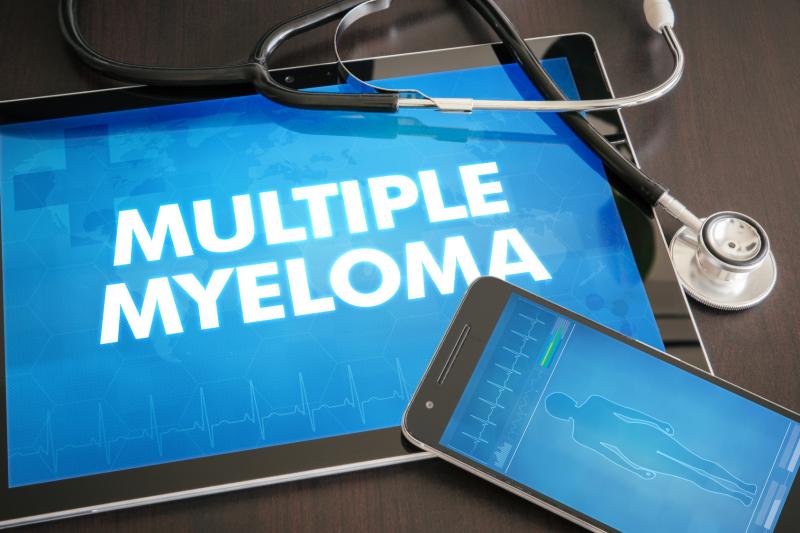
Transitioning from bortezomib- to ixazomib-based induction is feasible, tolerable and effective in the treatment of community patients with newly diagnosed multiple myeloma (NDMM), according to a study presented at the 61st Annual Meeting of the American Society of Hematology (ASH 2019).
“With 73 percent of patients remaining on therapy and enrolment continuing, duration of therapy is promising, substantial improvements in response have been seen, and electronic patient‑reported outcomes (ePRO) compliance/ medication adherence is high, indicating the feasibility and value of these evaluations,” the researchers said.
This study enrolled nontransplant NDMM patients (transplant-ineligible or transplant delayed >24 months) with ≥stable disease after 3 cycles of a bortezomib-based induction at 23 community sites to receive ixazomib-based therapy (ixazomib 4 mg, day 1, 8, 15; lenalidomide 25 mg, day 1–21; dexamethasone 40 mg [20 mg in patients aged >75 years], day 1, 8, 15, 22) for up to 26 x 28-day cycles or until progression/toxicity.
Patients completed ePROs every cycle to evaluate quality of life or treatment satisfaction, as well as a monthly medication adherence survey via a wearable device or smartphone. Progression-free survival (PFS) was the primary endpoint, while secondary endpoints included partial (PR), very good partial (VGPR) and complete (CR) response rates, and duration of therapy.
Of the participants (median age, 72 years; range, 49–90 years), 76 percent were elderly (≥65 years) and 47 percent were male.
There were extensive comorbidities at the start of ixazomib-based therapy, which included hypertension (51 percent), anaemia (44 percent), fatigue (42 percent), renal and urinary disorders (36 percent), gastro-oesophageal reflux disease (31 percent), cardiac disorders (27 percent), constipation (27 percent), nausea (24 percent), and peripheral neuropathy (16 percent). [ASH 2019, abstract 1882]
Majority (91 percent) of the patients were on concomitant medications. At data cutoff, 73 percent remained on therapy, with a median duration of 6.9 months of proteasome inhibitor (PI) therapy, including prior ixazomib-based induction. Meanwhile, median duration of ixazomib-based induction was 4.0 months, with patients receiving therapy up to 17.3 months.
After 3 cycles of bortezomib-based induction, the ≥VGPR and ≥CR rates were 27 percent and 4 percent, respectively, with an overall response rate (ORR) of 62 percent. The corresponding rates with ixazomib-based induction were 40 percent and 22 percent, with an ORR of 65 percent (15 percent not evaluable).
Transition to ixazomib-based induction led to deepened responses or an 18-percent increase in ≥CR rate in 21 patients (36 percent).
However, one patient had died and three had progressed at data cutoff. The preliminary PFS rates from start of ixazomib- and ixazomib-based induction were 91 percent (95 percent CI, 74–97 percent) and 96 percent (95 percent CI, 84–99 percent), respectively.
Compliance during ixazomib-based treatment was high at an average of 96 percent (n=61 patients; data cutoff, 8 July 2019). Patients recorded their monthly medication adherence for the previous 4 weeks. ‘Excellent’ or ‘very good’ adherence was reported by 81 percent (n=32) of evaluable patients in cycle 1, 81 percent (n=27) in cycle 2, 77 percent (n=22) in cycle 3, 96 percent (n=24) in cycle 4 and 94 percent (n=18) in cycle 5.
Adverse events (AEs) occurred in 87 percent of patients during ixazomib-based treatment to date, of whom 44 percent had grade 3/4 AEs, including grade 3 pneumonia, syncope and diarrhoea. AEs led to treatment modification in 47 percent and discontinuation in 4 percent of patients. Serious AEs were reported in 29 percent.
Additionally, 25 percent of patients had peripheral neuropathy, which led to dose modification in 13 percent. No on-study deaths (ie, occurring <30 days of last dose) were recorded.
“PI-based therapy is a standard of care for nontransplant NDMM patients,” the researchers said, noting, however, that long-term treatment that is associated with improved outcomes is difficult in the real-world setting.
“This may be due to a number of factors, including the burden of repeated intravenous/subcutaneous administration, distance from treatment centre, comorbidities and toxicity,” they added.